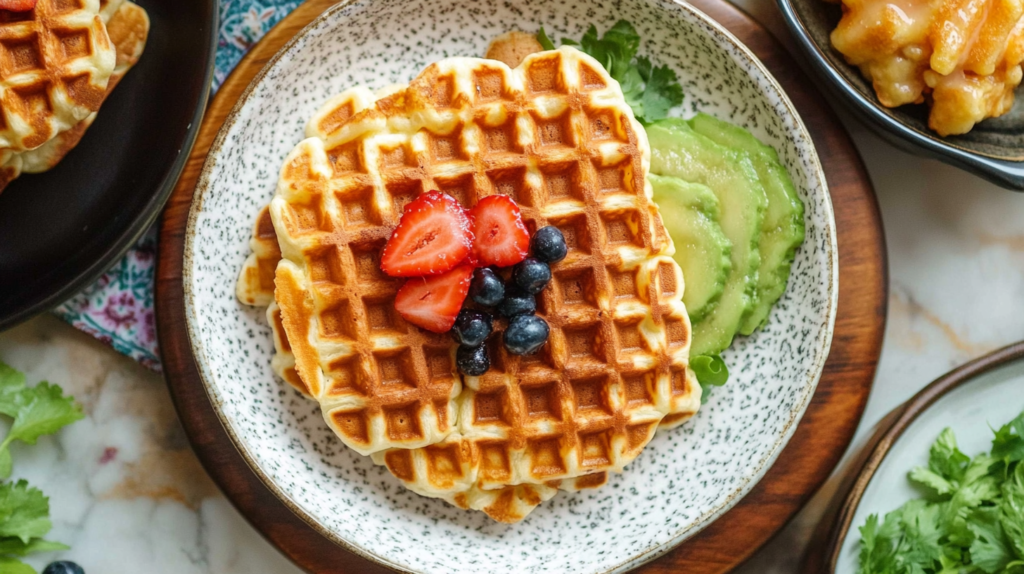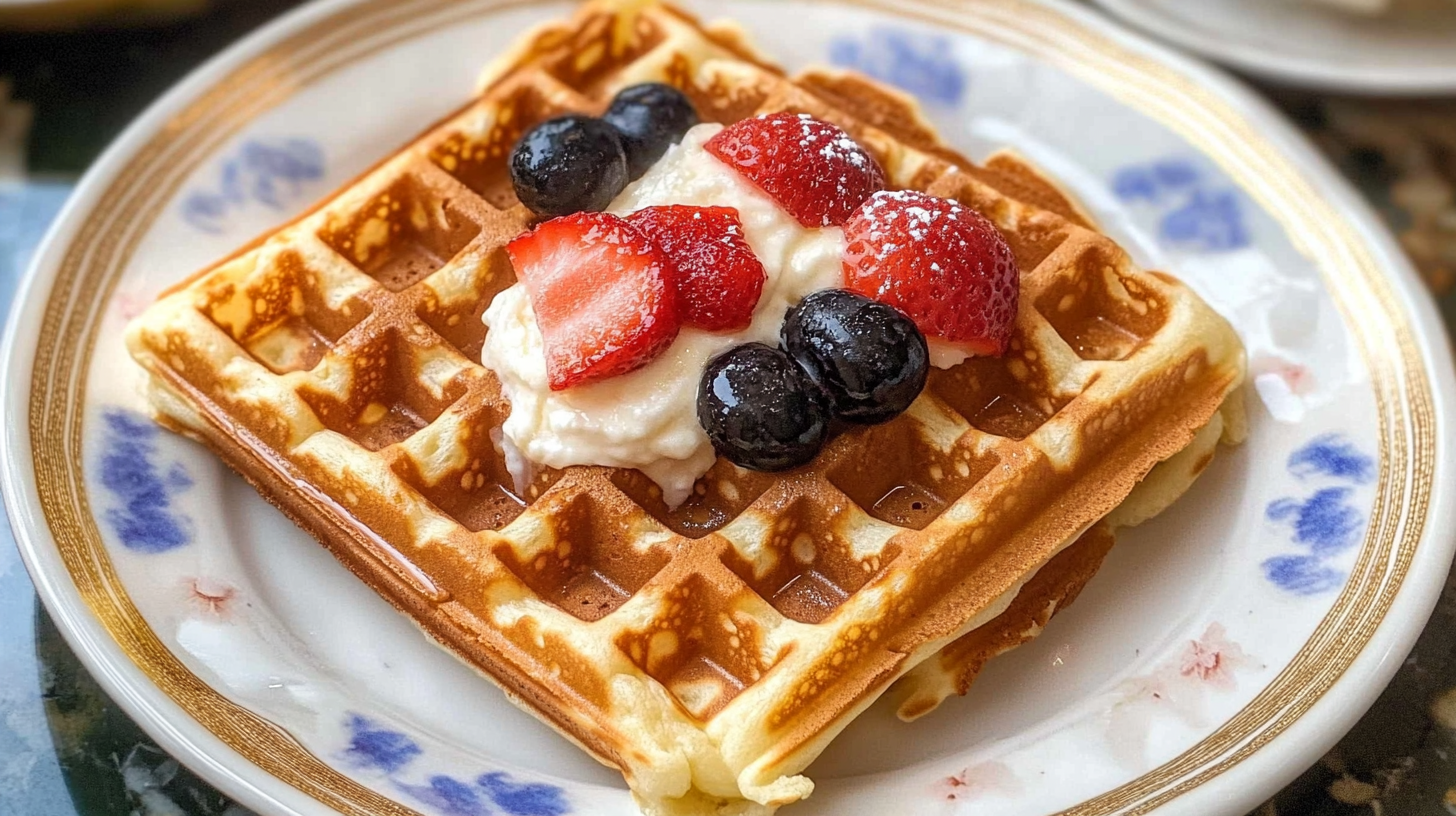Waffles are a breakfast or dessert staple known for their crispy exterior and soft, fluffy interior, making them a favorite for anyone who craves a warm, satisfying start to the day. This guide explores the history of waffles, the different types available, tips for achieving that perfect crispness, and step-by-step instructions for making homemade waffles from scratch. Whether you’re a fan of classic Belgian waffles, savory waffles, or are looking to try new toppings, this article covers everything you need to know to make waffles that will impress.
What Are Waffles?
A Breakfast Favorite Across the Globe
Waffles are a delicious, versatile breakfast food that has been enjoyed in various forms worldwide. Made from a simple batter of flour, milk, and eggs, these golden treats are cooked in a waffle iron, which gives them their iconic grid pattern. Waffles can be sweet or savory, topped with classic additions like maple syrup or fresh fruit, or customized with unique ingredients to suit any palate.
Why Waffles Are Loved
Waffles’ appeal lies in their crispy edges, which provide a perfect contrast to the tender interior. Each little square holds a dollop of toppings—whipped cream, nut butter, berries, or even yogurt—giving waffles a texture and flavor profile that’s hard to beat. And let’s not forget, they’re fun to make, with endless options to experiment with.
A Brief History of Waffles
Ancient Beginnings and European Origins
Waffles have been around for centuries, tracing back to ancient Greece, where similar flat cakes were cooked between two metal plates. However, the modern waffle as we know it started to take shape in medieval Europe. Back then, waffles were often thicker and less sweet, sometimes flavored with spices and cooked over an open flame.
Waffles Arrive in America
In the 1700s, waffles found their way to America, brought by Dutch settlers who introduced the earliest versions to the colonies. But it was Thomas Jefferson who truly popularized waffles by bringing a waffle iron from France, sparking what became known as “waffle frolics”—waffle-centric social gatherings that added to their charm.
Types of Waffles
Belgian Waffles
Belgian waffles are famous for their large, deep pockets that are perfect for holding syrup, fruit, and whipped cream. Known for their light, airy texture and crisp exterior, these waffles are often made with a yeast-based batter or with beaten egg whites, which give them a fluffy rise. Belgian waffles are usually larger than other types and are a popular choice in cafes and restaurants due to their impressive size and texture.
American Waffles
Compared to Belgian waffles, American waffles are thinner and have a smaller grid pattern. Typically made with a batter leavened with baking powder, American waffles have a crispier texture and are often served with breakfast staples like eggs, bacon, and hash browns. They’re versatile enough to go sweet or savory, pairing well with anything from maple syrup to fried chicken.
Liege Waffles
A unique treat among waffles, Liege waffles hail from Belgium and are known for their rich, dense texture. Made with a dough (rather than a batter) and pearl sugar, these waffles caramelize as they cook, giving them a sweet, chewy quality and a slightly crunchy exterior. Liege waffles are often eaten plain or with minimal toppings, as their flavor and texture are already indulgent.
Savory Waffles
Savory waffles are a fantastic twist on the traditional sweet waffle. Often made with ingredients like cheese, herbs, and even bacon, they’re perfect for those who prefer a less sweet breakfast or brunch option. Savory waffles pair well with toppings like avocado, smoked salmon, and poached eggs, making them a great choice for a hearty meal.
How to Make Waffles from Scratch
Essential Ingredients
To make the perfect waffles from scratch, you’ll need a few key ingredients:
- Flour: All-purpose flour is the most commonly used, but whole wheat or gluten-free flours work as well.
- Leavening Agent: Baking powder or yeast is essential for a fluffy, risen waffle.
- Sugar and Salt: These add flavor without making the waffles overly sweet.
- Milk and Eggs: These ingredients give moisture, structure, and richness to the batter.
- Butter or Oil: Adds flavor and ensures crispness when cooking.
Step-by-Step Instructions
- Mix Dry Ingredients: In a large mixing bowl, whisk together the flour, baking powder, sugar, and salt until evenly combined.
- Combine Wet Ingredients: In a separate bowl, whisk the eggs, milk, and melted butter or oil until well blended.
- Create the Batter: Pour the wet ingredients into the dry ingredients and stir just until combined. Be careful not to overmix; a few lumps are okay!
- Let the Batter Rest: Resting the batter for 5-10 minutes can improve texture and flavor by allowing the flour to fully hydrate.
- Cook in a Preheated Waffle Iron: Preheat your waffle iron, spray it lightly with non-stick spray, and pour in the batter. Cook until the waffles are golden brown and crispy on the outside.
For additional tips on creating perfect waffles, including how to adjust batter thickness, visit Betty Crocker’s guide on waffle-making.
Tips for Perfecting Waffles
Use Fresh Leavening Agents
Using fresh baking powder or yeast ensures that your waffles rise properly and achieve that ideal fluffy texture. Leavening agents lose potency over time, so replace them every few months for the best results.
Avoid Overmixing the Batter
Overmixing can make waffles tough and chewy by developing too much gluten. Stir just until the dry and wet ingredients are combined, and don’t worry if the batter has a few lumps—they’ll smooth out during cooking.
Let the Batter Rest
Allowing the batter to rest for 5-10 minutes can make a noticeable difference. This brief resting period gives the leavening agents time to work and lets the flour absorb the liquid, resulting in a lighter, fluffier waffle.
Maintain Medium Heat
Cooking waffles at medium heat ensures a crispy exterior without burning the outside before the interior is fully cooked. For the ideal golden brown texture, avoid setting your waffle iron to the highest heat.
For even more expert tips, check out Martha Stewart’s advice on basic waffle-making.
Serving Suggestions and Toppings

Classic Maple Syrup and Butter
You can’t go wrong with a classic topping of maple syrup and butter. The syrup’s natural sweetness and the butter’s rich creaminess bring out the best in waffles, highlighting their flavor without overpowering it.
Fresh Fruits and Berries
Adding fresh fruits like strawberries, blueberries, bananas, or even mango slices provides natural sweetness and a vibrant touch to your waffles. Fruit also adds a burst of color and nutrition, making your plate look as good as it tastes.
Nut Butters and Spreads
Nut butters, such as peanut butter or almond butter, offer a rich, savory balance to waffles. Spread a thin layer or drizzle for a unique twist that complements the waffle’s crisp texture and adds extra protein.
Yogurt and Honey
For a lighter option, top your waffles with a dollop of Greek yogurt and a drizzle of honey. This combination is creamy, slightly tangy, and sweet, creating a satisfying topping that’s not too heavy.
Frequently Asked Questions About Waffles
Can I Freeze Waffles?
Yes, you can freeze waffles, and it’s a fantastic way to have a quick breakfast on hand! Once your waffles are cooked, let them cool completely, then stack them with a piece of parchment paper between each one to prevent sticking. Place the stack in an airtight freezer bag, and they’ll keep for up to two months. To reheat, simply pop them in a toaster or warm them in a 375°F oven for 8-10 minutes.
How Long Does Waffle Batter Last?
Waffle batter can be stored in the refrigerator for up to 24-48 hours, though it’s best used within the first day for optimal rise and flavor. If your batter includes baking powder, the longer it sits, the less effective the leavening will be. Adding a pinch of fresh baking powder before cooking can help restore some of that lift.
Can I Make Waffles Without Eggs?
Yes, it’s easy to make egg-free waffles by using substitutes like applesauce, mashed bananas, or a “flax egg” (1 tablespoon ground flaxseed + 3 tablespoons water). These ingredients help bind the batter and keep the waffles moist, making them great for vegan waffles without sacrificing texture.
What Is the Difference Between Pancakes and Waffles?
While waffles and pancakes share similar ingredients, they have key differences in texture and cooking methods. Waffles are generally crispier and cooked in a waffle iron, creating the signature pockets and crispy edges. Pancakes, on the other hand, are softer and cooked on a griddle or skillet, resulting in a tender, cake-like texture. Waffle batter typically contains more fat or sugar, which helps them caramelize and become crispy.
Why Are My Waffles Not Crispy?
A few factors could be at play if your waffles aren’t as crispy as you’d like. Using too much batter or setting the heat too low on the waffle iron can lead to a soggier texture. For extra crispiness, try adding a tablespoon of cornstarch to your batter and make sure your iron is preheated and set to medium-high.
Conclusion
Making waffles from scratch is a joyful experience that brings a bit of cozy magic to any morning. With the simple ingredients and tips shared in this guide, you’re ready to whip up crispy, golden waffles that will be a hit with family or guests. The beauty of waffles is in their adaptability—from classic Belgian styles to inventive savory options, there’s a recipe for every palate and preference. So grab your waffle iron, experiment with different toppings, and savor the delightful crunch of homemade waffles. Enjoy your breakfast creation, and don’t forget to make it your own!

